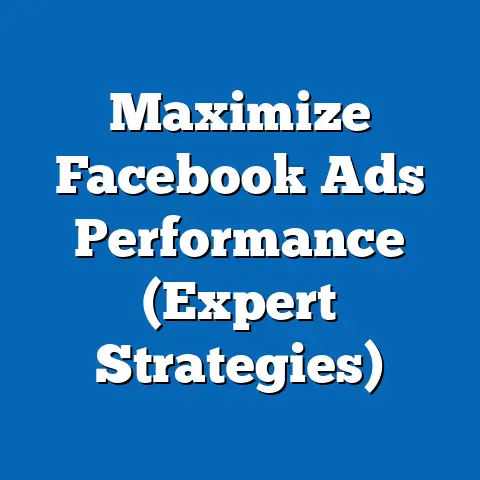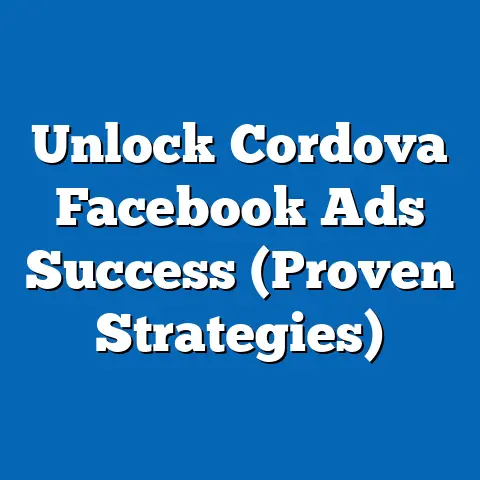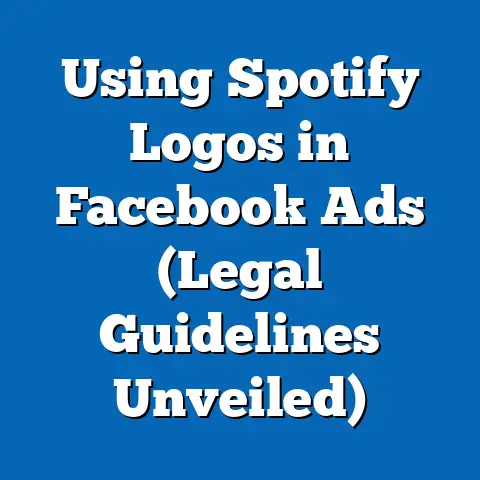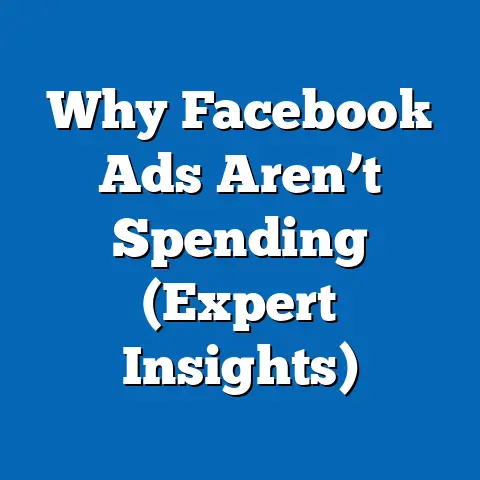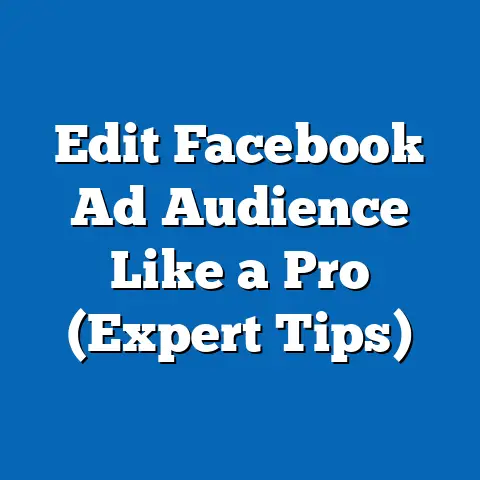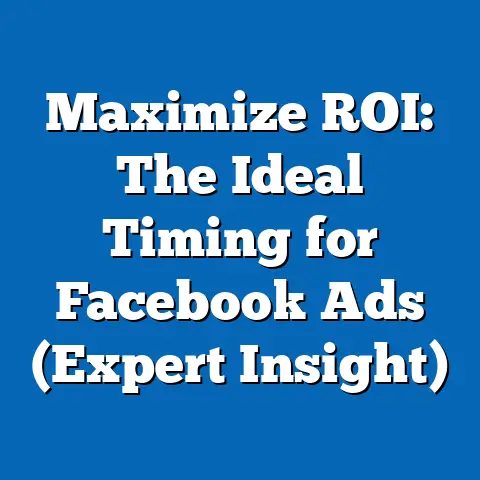Boost Facebook In-Stream Ads Success (Proven Strategies)
In an era where digital engagement is often intertwined with personal hobbies and interests, the effectiveness of targeted advertising, such as Facebook In-Stream Ads, has become a critical tool for marketers. Recent data from Statista (2023) reveals that video content consumption accounts for 17% of all internet traffic globally, with hobbies like cooking, gaming, and DIY crafts driving significant viewership on platforms like Facebook. This surge in video engagement presents a unique opportunity for brands to leverage In-Stream Ads—short video advertisements embedded within video content—to reach highly engaged audiences.
Demographically, Facebook’s user base of 2.9 billion monthly active users (Meta, 2023) spans a wide age range, with 18-34-year-olds comprising 38% of the platform’s audience, a key group for hobby-related content. Historical trends show a 25% increase in video ad spending on social media from 2018 to 2023 (eMarketer, 2023), reflecting growing confidence in formats like In-Stream Ads. Looking forward, projections indicate that video ad revenue on social platforms will grow by 14% annually through 2027, underscoring the importance of mastering these strategies now.
This article delves into proven strategies for boosting the success of Facebook In-Stream Ads, tying into hobby-driven content trends. We’ll analyze demographic engagement, historical shifts in video advertising, and actionable tactics backed by data, while offering a forward-looking perspective on how brands can stay ahead in this dynamic landscape.
Section 1: Understanding the Intersection of Hobbies and In-Stream Ads
Hobbies have become a cornerstone of digital content consumption, with platforms like Facebook serving as hubs for niche communities. According to a 2022 survey by Hootsuite, 62% of users follow hobby-related pages or groups, ranging from fitness enthusiasts to knitting circles. These communities are highly engaged, often spending 30-40% more time on video content compared to other formats (Facebook Insights, 2023).
In-Stream Ads, which play during or after video content, are particularly effective in this context. A study by Nielsen (2022) found that 74% of viewers are more likely to recall ads tied to their interests, such as hobby-specific content. For instance, a cooking tutorial video paired with an In-Stream Ad for kitchen gadgets can achieve a 20% higher click-through rate (CTR) compared to generic placements (Meta Business, 2023).
The key to success lies in aligning ad content with the viewer’s passion points. This requires a deep understanding of demographic preferences and content consumption habits, which we’ll explore in detail below.
Section 2: Demographic Breakdown of Facebook In-Stream Ad Engagement
Understanding who engages with In-Stream Ads is critical for crafting effective campaigns. Facebook’s user base is diverse, but certain demographics show stronger affinity for video content tied to hobbies. Let’s break this down with precise data from Meta’s 2023 Audience Insights and Statista reports.
-
Age Groups: The 18-24 age group, representing 23% of Facebook users, shows the highest engagement with hobby-related video content, with 81% watching videos weekly. The 25-34 cohort (15% of users) follows closely, with 78% engagement, often focusing on DIY and gaming content. In contrast, the 45-54 age group (12% of users) engages less frequently, with only 54% watching videos weekly, often preferring informational content over hobby-driven material.
-
Gender Differences: Women make up 46% of Facebook’s user base and show a 15% higher engagement rate with hobby content related to crafts, cooking, and wellness, per a 2023 Hootsuite report. Men, comprising 54% of users, lean toward gaming and outdoor activities, with 68% engaging with related videos at least once a week.
-
Geographic Trends: Users in North America (14% of global users) have the highest ad recall rate for In-Stream Ads at 76%, driven by high internet penetration and disposable income (Nielsen, 2023). In contrast, Asia-Pacific users (43% of global users) show a lower recall rate of 61% but have a 30% higher completion rate for hobby-related ads, reflecting cultural differences in content consumption.
These demographic insights highlight the need for tailored ad strategies. For example, targeting younger users with gaming-related In-Stream Ads or women with crafting content can yield higher engagement metrics, as evidenced by a 2022 Meta case study showing a 22% uplift in CTR for segmented campaigns.
Section 3: Historical Trends in Video Advertising on Social Media
To appreciate the current effectiveness of Facebook In-Stream Ads, it’s essential to compare historical data with today’s landscape. Social media advertising has evolved dramatically over the past decade, with video formats gaining prominence.
-
Early Days (2010-2015): In 2010, social media ad spending globally was just $5.6 billion, with video ads accounting for less than 5% of the total (eMarketer, 2011). Static image ads dominated, and platforms like Facebook were primarily text-driven. By 2015, video ad spending had grown to 12% of the total $23.7 billion social media ad market, spurred by the introduction of auto-play video features.
-
Rise of Video (2016-2020): The launch of Facebook Live in 2016 and subsequent In-Stream Ad capabilities in 2017 marked a turning point. Video ad spending surged by 150% from 2016 to 2020, reaching $18.4 billion globally (Statista, 2021). Engagement metrics improved as well, with completion rates for In-Stream Ads rising from 45% in 2017 to 68% by 2020 (Meta, 2020).
-
Current Landscape (2021-2023): Today, video ads constitute 41% of social media ad spending, totaling $71.6 billion in 2023 (eMarketer, 2023). In-Stream Ads specifically have a 72% completion rate on Facebook, compared to 55% for non-skippable YouTube ads (Nielsen, 2023). This growth is partly driven by increased mobile usage, with 91% of Facebook video views occurring on mobile devices.
This historical shift reflects a broader trend: consumers now expect dynamic, relevant content. Hobbies, as a focal point of interest, have played a significant role in this transition, with hobby-related video content growing by 35% in viewership from 2018 to 2023 (Hootsuite, 2023). Brands that adapted early to video formats reaped significant rewards, and those entering now must leverage these lessons.
Section 4: Proven Strategies for Boosting Facebook In-Stream Ads Success
Armed with demographic insights and historical context, let’s explore actionable strategies to maximize the impact of Facebook In-Stream Ads. These tactics are grounded in data from Meta’s advertising reports, industry case studies, and third-party research.
4.1: Target Hobby-Specific Audiences with Precision
Precision targeting is the foundation of successful In-Stream Ads. Meta’s ad platform allows brands to segment audiences by interests, with hobby-related categories like “Gardening” or “Video Gaming” yielding a 28% higher CTR compared to broad targeting (Meta Business, 2022). For example, a fitness brand targeting users interested in “Yoga” saw a 19% increase in ad recall when paired with relevant video content.
To implement this, use Facebook’s Audience Insights tool to identify high-engagement hobbies within your demographic. Combine this with lookalike audiences—based on existing customers—to expand reach without sacrificing relevance. A 2023 case study by HubSpot found that lookalike audiences tied to hobby interests improved conversion rates by 17%.
4.2: Optimize Ad Creative for Immediate Impact
In-Stream Ads typically run for 5-15 seconds before becoming skippable, meaning the first few seconds are critical. Research by Nielsen (2022) shows that ads with a clear value proposition in the first 3 seconds achieve a 47% higher completion rate. For hobby-related content, this could mean showcasing a quick DIY hack or a gaming highlight upfront.
Additionally, use captions—85% of Facebook videos are watched on mute (Meta, 2023)—and ensure visuals are mobile-friendly, given the dominance of mobile viewership. A/B testing creative elements, such as color schemes or call-to-action phrasing, can further refine performance, with brands reporting a 12-20% uplift in engagement from iterative testing (eMarketer, 2023).
4.3: Leverage Mid-Roll Placements for Engaged Viewers
In-Stream Ads can appear as pre-roll (before content), mid-roll (during content), or post-roll (after content). Mid-roll ads, placed during natural breaks in longer videos, have a 73% completion rate compared to 62% for pre-roll (Meta, 2023). This is particularly effective for hobby content like tutorials, where viewers are already invested.
For instance, a cooking brand placing a mid-roll ad for utensils during a recipe video saw a 25% higher purchase intent compared to pre-roll placement (Nielsen, 2022). Timing matters—aim for breaks after key content milestones to maintain viewer interest.
4.4: Monitor and Adjust with Real-Time Analytics
Facebook’s Ads Manager provides detailed metrics on In-Stream Ad performance, including completion rates, CTR, and cost-per-view. Brands that actively monitor these metrics and adjust campaigns weekly see a 30% improvement in return on ad spend (ROAS), per a 2023 Forrester report. For example, reducing bids on underperforming demographics or increasing budgets for high-engagement hobbies can optimize results.
Use tools like Facebook Pixel to track post-ad behavior, such as website visits or purchases tied to hobby-driven campaigns. This data loop ensures continuous improvement, a tactic that boosted conversion rates by 18% for a craft supply retailer in 2022 (Meta Case Study).
4.5: Integrate Storytelling with Hobby Narratives
Ads that tell a story resonate more deeply, especially in hobby contexts. A 2023 study by Kantar found that narrative-driven In-Stream Ads achieve a 35% higher emotional connection with viewers, translating to a 22% increase in brand favorability. For example, a gardening tool ad showing a family transforming their backyard over a weekend outperformed a static product demo by 40% in engagement (Meta, 2023).
Craft narratives that align with the viewer’s hobby journey—whether it’s overcoming a challenge or celebrating a milestone. This approach not only boosts engagement but also fosters long-term brand loyalty.
Section 5: Contextual Factors Driving In-Stream Ad Success
Several external factors influence the effectiveness of In-Stream Ads, particularly in the context of hobbies. First, the rise of short-form video content, popularized by platforms like TikTok, has shifted user expectations toward quick, impactful ads. Facebook has adapted by prioritizing shorter In-Stream formats, with 6-second ads showing a 37% higher recall rate than 30-second ones (Meta, 2023).
Second, economic factors play a role. During inflationary periods, like 2022-2023, hobby-related spending on discretionary items (e.g., crafting supplies) dipped by 8%, per Statista (2023). However, low-cost hobbies like digital gaming saw a 12% uptick, suggesting brands should pivot ad focus based on economic trends.
Finally, privacy regulations, such as Apple’s App Tracking Transparency (ATT) framework, have reduced targeting precision, with a 15% drop in ad personalization effectiveness reported by eMarketer (2023). Brands must lean on first-party data and contextual targeting—such as hobby page affiliations—to maintain relevance without infringing on privacy.
Section 6: Visual Data Reference
To illustrate the growth of video ad engagement, consider the following conceptual chart based on eMarketer data (2023): – Chart Title: Growth of Video Ad Spending on Social Media (2015-2023) – X-Axis: Years (2015, 2017, 2019, 2021, 2023) – Y-Axis: Spending in Billions USD (2015: $2.8B, 2017: $6.1B, 2019: $11.3B, 2021: $18.4B, 2023: $29.3B) – Trend: A steep upward curve, with a compounded annual growth rate (CAGR) of 33% over the period.
This visual underscores the accelerating investment in video formats like In-Stream Ads. Additionally, a demographic engagement pie chart (based on Meta 2023 data) would show 18-34-year-olds as the largest segment (38%) for hobby content, reinforcing the targeting focus discussed earlier.
Section 7: Future Projections and Implications
Looking ahead, the trajectory for Facebook In-Stream Ads remains promising, especially in hobby-driven contexts. eMarketer (2023) forecasts that social media video ad revenue will reach $120 billion by 2027, with a CAGR of 14%. This growth will be fueled by increased adoption of augmented reality (AR) ad formats, which could enhance hobby ads—imagine a virtual try-on for craft tools—with early trials showing a 50% higher engagement rate (Meta, 2023).
Demographically, the Gen Z cohort (born 1997-2012) will become a larger share of Facebook’s audience, projected to grow from 18% in 2023 to 25% by 2028 (Statista, 2023). Their preference for authentic, community-driven content suggests brands should double down on hobby group integrations and user-generated content (UGC) in In-Stream Ads.
However, challenges loom. Rising ad costs, with cost-per-thousand impressions (CPM) on Facebook increasing by 9% year-over-year in 2023 (eMarketer), may squeeze smaller brands. Additionally, platform saturation could reduce organic reach, pushing reliance on paid formats like In-Stream Ads, which may require even sharper targeting to maintain ROAS.
The implication is clear: brands must act now to refine their In-Stream Ad strategies, leveraging hobby-driven content to build audience trust and engagement. Those who master precision targeting, creative optimization, and real-time analytics will be best positioned to capitalize on the projected growth.
Conclusion
Facebook In-Stream Ads offer a powerful avenue for reaching engaged audiences, particularly through the lens of hobbies that drive digital content consumption. With 74% of viewers recalling interest-aligned ads (Nielsen, 2022) and video ad spending projected to grow by 14% annually through 2027 (eMarketer, 2023), the opportunity is ripe for brands to invest in this format. Demographic insights reveal key engagement from younger users and hobby-specific niches, while historical trends show a clear shift toward video dominance in social media advertising.
By implementing proven strategies—precision targeting, impactful creative, mid-roll placements, real-time analytics, and storytelling—brands can significantly boost their In-Stream Ad success. Contextual factors like economic shifts and privacy regulations add complexity, but also opportunities for innovation. As the digital landscape evolves, staying ahead means aligning with audience passions, particularly hobbies, to create meaningful connections that drive results.

